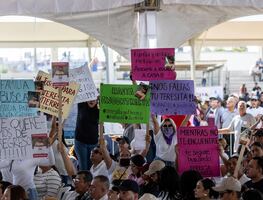Más Información

Osiel Cárdenas, exlíder del Cártel del Golfo, recibe auto de formal prisión; enfrentará juicio por homicidio

Jóvenes mexicanos pasan más de 2 mil horas al año en el teléfono; OCDE alerta sobre su impacto en la salud mental

Sergio Gutiérrez Luna destaca aprobación de 25 reformas en la 66 Legislatura; "Un logro histórico para la 4T", señala

Secretario de Agricultura reafirma defensa del maíz blanco; "Seguiremos apoyando la producción nacional no transgénica", afirma

¿Maíz transgénero? Rubén Rocha corrige desliz durante discurso en Sinaloa; destaca importancia del maíz blanco

Sheinbaum asegura apoyo total a Sinaloa para enfrentar violencia; "Nunca los vamos a dejar solos, aquí está la presidenta"
By Giselle Rodríguez
The U.S. Drug Enforcement Administration (DEA) published its updated assessment of the areas of dominant control of the major drug trafficking organizations in Mexico.
According to the July 2015 report, prepared by the agency's Strategic Intelligence Section, the DEA "continues to identify eight major cartels currently operating in Mexico: Sinaloa, Cartel de Jalisco Nueva Generación (New Generation Jalisco Cartel or CJNG), Beltrán-Leyva Organization (BLO), Los Zetas, Gulf, Juárez/La Línea, La Familia Michoacana (LFM), and Los Caballeros Templarios (Knights Templar or LCT)."
The DEA noted that "the CJNG has become the fastest growing drug trafficking organization in Mexico. From its stronghold in Jalisco, the organization’s influence extends to Nayarit, Colima, Guerrero, Veracruz, Michoacán, and other Mexican states. DEA reporting indicates the organization has recently expanded its dominion to Guanajuato and San Luis Potosí, in addition to an increased presence along the southern Mexican coast states of Oaxaca and Chiapas."
It added that the CJNG, that splintered from the Sinaloa Cartel in 2010, "uses its alliances and exploits weaknesses of rival cartels to take over new territories or increase its presence in areas already under CJNG control. The disintegration of the Knights Templar cartel in 2015, paved the way for the CJNG to flourish and expand its territorial presence in Michoacán. The internal power struggles and disarray suffered by the Gulf Cartel and Los Zetas are also likely contributing to the CJNG expansion. With additional territory and reach, the CJNG is in a prime position to increase its drug trafficking operations, wealth, and influence in Mexico."
The report also states that "leadership losses for La Familia Michoacana and the Knights Templar cartel over the last year have significantly degraded their operational capabilities and organizational cohesion."
According to the report "Mexico's Drug War" published in March 2014 by the Council on Foreign Relations, "officials estimate that the drug trade makes up 3 to 4 percent of Mexico's US$1.2 trillion annual GDP—totaling as much as US$30 billion—and employs at least half a million people."
It added that "Mexico is a major supplier of heroin to the U.S. market, and the largest foreign supplier of methamphetamine and marijuana. Mexican production of all three of these drugs has increased since 2005, as has the amount of drugs seized at the southwest border, according to the U.S. Department of Justice. More than 90 percent of cocaine now travels through Mexico into the United States, up from 77 percent in 2003."




